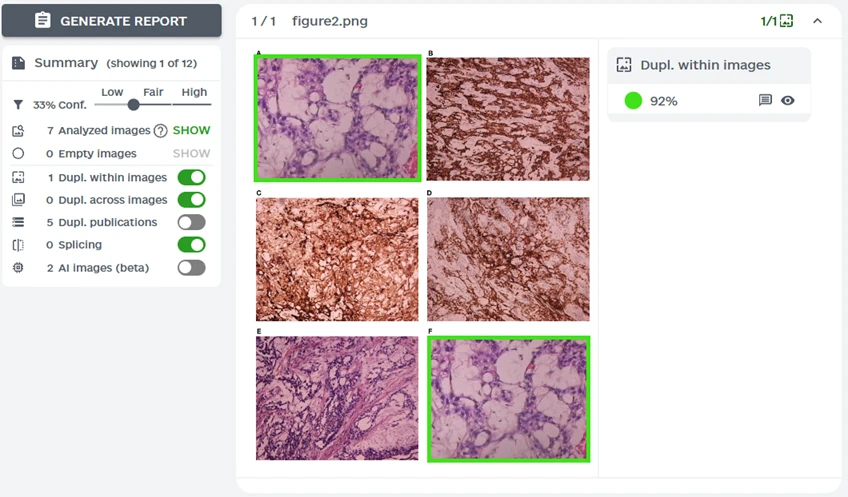Image Integrity Tool for Researchers
Imagetwin equips researchers with AI-powered image analysis tools to ensure their figures are free of integrity concerns before submission. Publish with a peace of mind.

Detect accidental duplications, mislabeling, and overlooked image manipulations before submitting to journals
Use Imagetwin's built-in Forensic Tools and Confidence Scores to verify and refine your images
Reduce the risk of delays, rejections, or post-publication corrections due to image integrity issues
Solution for Researchers
Imagetwin automates image integrity checks, allowing researchers to identify and fix issues early, improving their chances of a smooth peer-review process and successful publication. By using Imagetwin’s AI-driven tools, researchers can focus on what matters most, advancing scientific discovery with integrity.

Why Image Integrity is Critical for Researchers
Scientific images are central to research credibility. However, unintentional errors, image duplications, and manipulations can lead to:
Integrity issues flagged during review can slow down or even prevent publication.
Submitting papers with undetected image integrity issues could impact your academic credibility.
Mistakes found after publication can lead to costly corrections or retractions, affecting career progress.
Features Tailored for Researchers
Examine flagged images in detail with zoom, contrast adjustment, and keypoint matching to verify integrity concerns
Your data is never stored in our global dataset after scanning, and all uploads are fully encrypted for security
Assigns a probability score from 0% to 100% to help assess the severity of detected issues, allowing reviewers to prioritize critical cases
Generate a detailed PDF report summarizing all detected issues for internal review or journal submission
See How Imagetwin Works
We have prepared example papers you can scan for free using our software. Create an account and see how it works.
Why should I check my images before submission?
Scientific journals have strict image integrity guidelines. Even unintentional duplications or manipulations can cause delays, rejections, or corrections after publication. Using Imagetwin before submission ensures that your figures are peer-review ready.
How does Imagetwin help me during peer review?
If integrity concerns are raised during peer review, you may be required to address flagged issues. With Imagetwin, you can preemptively detect and resolve concerns, reducing the risk of unexpected hurdles.
What types of image issues does Imagetwin detect?
Imagetwin detects:
- Duplications within manuscripts
Duplications across literature - Splicing and copy-move forgeries
- AI-generated images
- Contrast or brightness modifications that obscure data
Is Imagetwin only for detecting fraud?
No. Imagetwin is designed to help researchers catch honest mistakes before submission. Many integrity issues arise unintentionally, and this tool ensures accuracy, transparency, and compliance with journal standards.
How does Imagetwin ensure my data is secure?
All uploaded manuscripts and images are fully encrypted, and scans are never stored in our global dataset after processing. Your research remains confidential at all times.
Can I use Imagetwin for images that have already been published?
Yes. Researchers can use Imagetwin to check previously published figures to ensure they meet integrity standards or as part of a post-publication review process.
Can I generate a report to submit with my manuscript?
Yes. Imagetwin provides a detailed PDF report that summarizes flagged image integrity concerns. This can be used for internal review or submitted with your manuscript for transparency.
How long does a scan take?
Most scans complete within seconds, even for multiple images or large manuscripts.
How can I access Imagetwin?
Researchers can choose from flexible scan packages based on their needs.